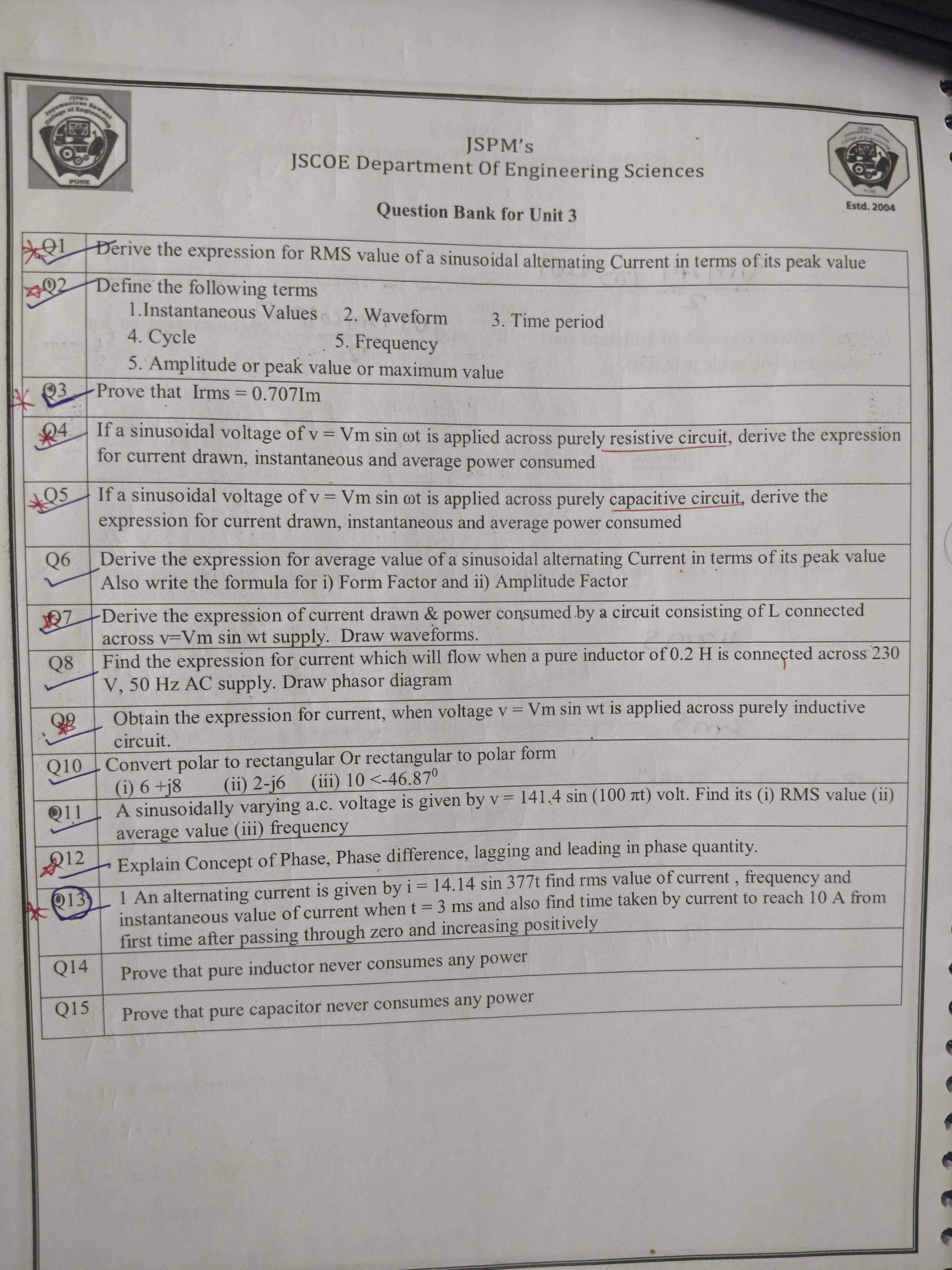Derive the expression for RMS value of a sinusoidal alternating current in terms of its peak value. Define the following terms: 1. Instantaneous Values 2. Waveform 3. Time period 4... Derive the expression for RMS value of a sinusoidal alternating current in terms of its peak value. Define the following terms: 1. Instantaneous Values 2. Waveform 3. Time period 4. Cycle 5. Frequency 6. Amplitude or peak value or maximum value. Prove that Irms = 0.707Im. If a sinusoidal voltage of v = Vm sin ωt is applied across a purely resistive circuit, derive the expression for current drawn, instantaneous and average power consumed. If a sinusoidal voltage of v = Vm sin ωt is applied across a purely capacitive circuit, derive the expression for current drawn, instantaneous and average power consumed. Derive the expression for average value of a sinusoidal alternating current in terms of its peak value. Also write the formula for i) Form Factor and ii) Amplitude Factor. Find the expression for current which will flow when a pure inductor of 0.2 H is connected across 230 V, 50 Hz AC supply. Draw phasor diagram. Obtain the expression for current, when voltage v = Vm sin ωt is applied across purely inductive circuit. Convert polar to rectangular Or rectangular to polar form: (i) 6 + j8 (ii) 2 - j6 (iii) 10 < -46.87°. A sinusoidally varying a.c. voltage is given by v = 141.4 sin (100 πt) volt. Find its (i) RMS value (ii) average value (iii) frequency. Explain Concept of Phase, Phase difference, lagging and leading in phase quantity. An alternating current is given by i = 14.14 sin 377t find rms value of current, frequency and instantaneous value of current when t = 3 ms and also find time taken by current to reach 10 A from first time after passing through zero and increasing positively. Prove that pure inductor never consumes any power. Prove that pure capacitor never consumes any power.

Understand the Problem
The questions are primarily related to electrical engineering concepts, particularly focused on alternating current, impedance, and circuit analysis. They ask for derivations, definitions, calculations, and proofs related to sinusoidal waveforms and their properties.
Answer
Irms = 0.707 * Im. Define key AC terms. For resistive: I=Vm/R sin(ωt). Capacitive: I=Vm/Xc cos(ωt). Average current: 0.637 * Im. In pure elements, no power is consumed.
The expression for the RMS value of a sinusoidal alternating current is Irms = 0.707 * Im. Definitions: Instantaneous values are values at a specific time; waveform is the shape of the voltage/current over time; time period is the duration of one cycle; cycle is a full wave cycle; frequency is the number of cycles per second; amplitude is the peak value. For a purely resistive circuit, the current is given by I = Vm/R sin(ωt). For a purely capacitive circuit, the current is I = Vm/Xc cos(ωt). The average value of a sinusoidal current is 0.637 * Im. Form factor is RMS/Average; Amplitude factor is Peak/RMS. For a pure inductor or capacitor, power is never consumed.
Answer for screen readers
The expression for the RMS value of a sinusoidal alternating current is Irms = 0.707 * Im. Definitions: Instantaneous values are values at a specific time; waveform is the shape of the voltage/current over time; time period is the duration of one cycle; cycle is a full wave cycle; frequency is the number of cycles per second; amplitude is the peak value. For a purely resistive circuit, the current is given by I = Vm/R sin(ωt). For a purely capacitive circuit, the current is I = Vm/Xc cos(ωt). The average value of a sinusoidal current is 0.637 * Im. Form factor is RMS/Average; Amplitude factor is Peak/RMS. For a pure inductor or capacitor, power is never consumed.
More Information
RMS and average values are crucial for calculating effective and average power consumed by resistive, capacitive, and inductive loads in AC circuits.
Tips
A common mistake is confusing RMS and average values; remember RMS is used for power calculations while average is a simple mean.
Sources
- RMS Voltage of a Sinusoidal AC Waveform - Electronics Tutorials - electronics-tutorials.ws
- Peak and RMS Value Of An Alternating Current (AC) - BYJU'S - byjus.com
AI-generated content may contain errors. Please verify critical information